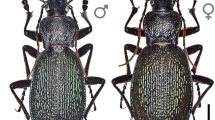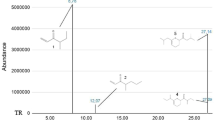Abstract
The Cataglyphis bicolor group of species of desert-dwelling ants, difficult to identify from morphological features alone, can be readily recognized by the contents of their postpharyngeal glands. Analysis by linked gas chromatography–mass spectrometry of glands from colonies identified only by code numbers showed in all samples straight and branched-chain alkanes and linear alkenes. C. viaticus, C. bicolor, and C. savignyi, the three species most difficult to distinguish morphologically, each contained distinctly different patterns of hydrocarbons, as illustrated by cluster analysis. The 16 most abundant hydrocarbons in the whole group of samples were selected and plotted as windrose diagrams. The differences in the windroses have more visual impact than gas chromatograms of the same data. The only case where there was any similarity was that between C. bicolor and C. diehlii, and even there the resemblance was not close. C. bombycinus is a sympatric species but is recognized as not belonging to the bicolor group by its different mandibular gland substances. It also was easily distinguished by its postpharyngeal gland contents from the other species.
Similar content being viewed by others
REFERENCES
Agosti, D. 1990. Review and reclassification of Cataglyphis (Hymenoptera, Formicidae). J. Nat. Hist. 24:1457-1505.
Agosti, D., Austin, C., GÖkÇen, O. A., KÖnig, W. A., Morgan, E. D., Scott, E. D., and Wehner, R. 1996. (S)-2-Methyl-1-hexanol, characteristic mandibular gland substance of ants of the Cataglyphis bicolor group. Chemoecology 7:57-60.
BagnÈres, A.-G., and Morgan, E. D. 1991. The postpharyngeal glands and the cuticle of Formicidae contain the same characteristic hydrocarbons. Experientia 47:106-111.
Bonavita-Cougourdan, A., BagnÈres, A.-G., Provost, E., Dusticier, G., and ClÉment, J.-L. 1997. Plasticity of the cuticular hydrocarbon profile of the slave-making ant Polyergus rufescens depends on the social environment. Comp. Biochem. Physiol. B, Biochem. Mol. Biol. 116:278-302.
Doi, M., Nemoto, T., Nakanishi, H., Kuwahara, Y., and Oguma, Y. 1997. Behavioral response of males to major sex pheromone component (Z,Z)-5,25-hentriacontadiene of Drosophila ananassae females. J. Chem. Ecol. 23:2067-2078.
Hefetz, A., Errard, C., Chambris, A., and Lenegrate, A. 1996. Postpharyngeal gland secretion as a modifier of aggressive behaviour in the myrmicine ant Manica rubida. J. Insect Behav. 9:709-717.
Heifetz, Y., Boekhoff, I., Breer, H., and Applebaum, S. W. 1997. Cuticular hydrocarbons control behavioural phase transition in Schistocerca gregaria nymphs and elict biochemical responses in antennae. Insect Biochem. Mol. Biol. 27:563-568.
Kaib, M., Heinze, J., and Ortius, D. 1993. Cuticular Hydrocarbon profiles in the slave-making ant Harpagognathus sublaevis and its hosts. Naturwissenschaften 80:281-285.
Keegans, S. J., Morgan, E. D., Agosti, D., and Wehner, R. 1992. What do glands tell us about species? A chemical study of Cataglyphis ants. Biochem. Syst. Ecol. 20:559-572.
Morgan, E. D. 1990. Preparation of small scale samples from insects for chromatography. Anal. Chim. Acta 236:227-235.
Morgan, E. D., and Wadhams, L. J. 1972. Gas chromatography of volatile compounds in small samples of biological materials. J. Chromatogr. Sci. 10:528-529.
Santschi, F. 1929. Etudes sur les Cataglyphis. Rev. Suisse Zool. 36:25-70.
Singer, T. L., and Espelie, K. E. 1996. Nest surface hydrocarbons facilitate nestmate recognition for the social wasp Polistes metricus Say (Hymenoptera: Vespidae). J. Insect Behav. 9:857-870.
Wehner, R. 1994. The polarization-vision project: Championing organismic biology, Fortschr. Zool. 39:103-143.
Wehner, R., Wehner, S., and Agosti, D. 1994. Patterns of biogeographic distribution within the bicolor species group of North African desert ant Cataglyphis Foerster 1850. Senckenbergiana Biol. 74:163-191.
Author information
Authors and Affiliations
Rights and permissions
About this article
Cite this article
Oldham, N.J., Morgan, E.D., Agosti, D. et al. Species Recognition from Postpharyngeal Gland Contents of Ants of the Cataglyphis bicolor Group. J Chem Ecol 25, 1383–1393 (1999). https://doi.org/10.1023/A:1020935011325
Issue Date:
DOI: https://doi.org/10.1023/A:1020935011325




